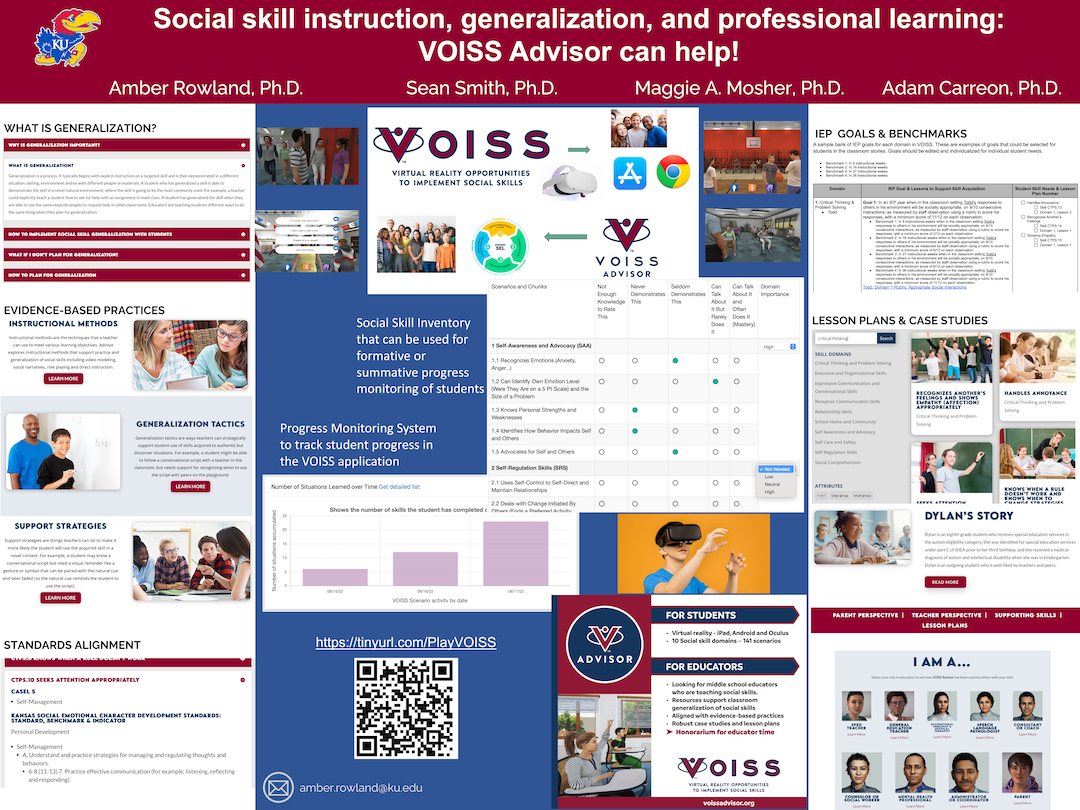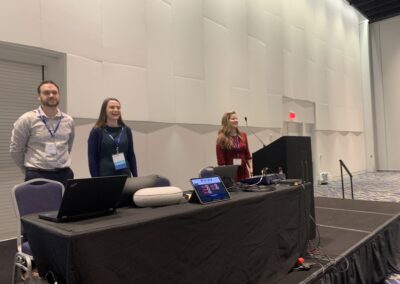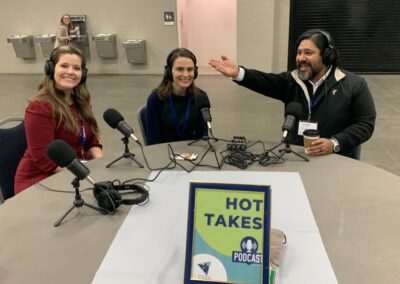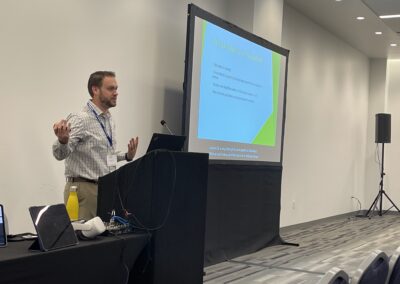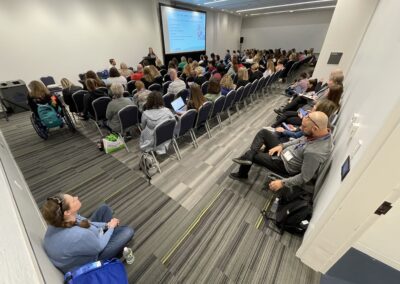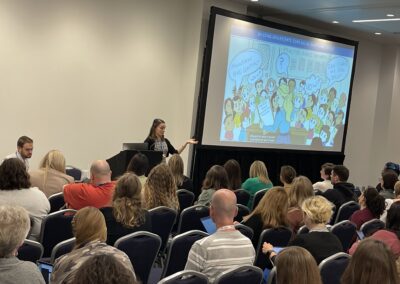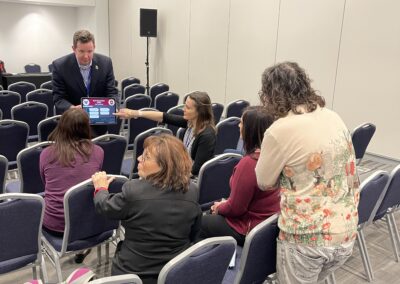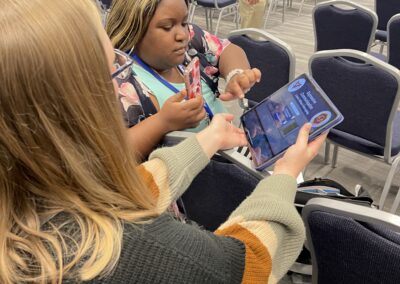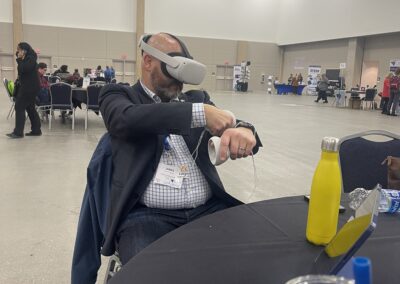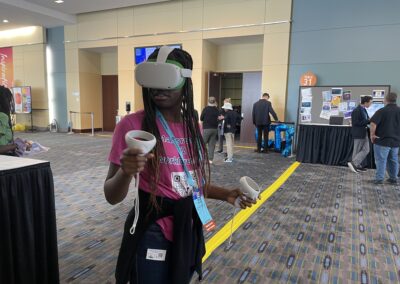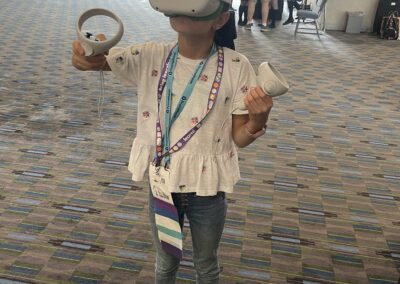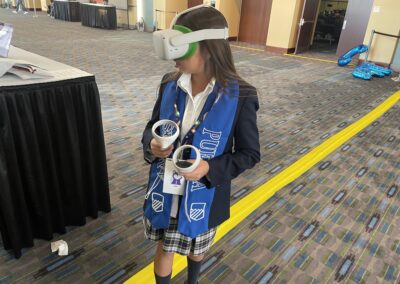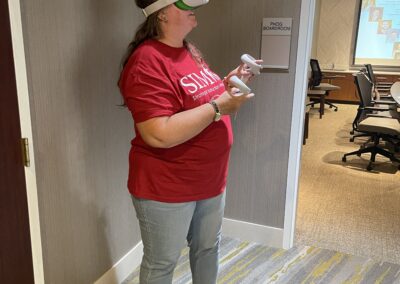Research Base
Virtual reality is a promising tool that aligns with the growing evidence that technology-aided instruction has been found to increase learner independence and decrease reliance on others for support.
Publications
Presentations
Recent Conference Presentation:
Click image to view full sized poster
The VOISS team has been busy presenting at CEC, ISTE, AERA, having students play VOISS and educators explore VOISS Advisor. The poster above was recently shared at ISTE in Philadelphia and the pictures are of students and educators playing VOISS with us!
Select Supporting Literature
Virtual reality can be better suited for students with disabilities because it removes stimuli from the environment, manipulates time (allowing for short breaks), and allows subjects to learn while playing (Vera et al., 2007). In our examination, we have concentrated our efforts on virtual reality for students with disabilities. While there is additional literature involving K-12 general education, the focus and relevance differ from what we are learning for students with disabilities. For example, the majority of virtual reality literature for students with disabilities focuses on children with autism spectrum disorder (ASD) between ages 6 through 18. In a review of research over the previous twenty years, all but one article involved participants with ASD. Not surprisingly, the primary variables studied are social skill related, as interaction with the environment is a useful feature of virtual reality.
The early virtual environments were online spaces where people could navigate their avatar to a common area with the purpose of being social (e.g., iCafe and Secondlife). Of the 16 articles, 12 primarily focused on social skills. For example, Ke and Im (2013) utilized a virtual reality intervention through the Secondlife platform on a desktop computer, to aid students in responding and maintaining interactions with peers. They found that students who participated showed increased performance in social interactions. Additional research addressed skills where students practiced fire alarm drills and street crossing. Self, Scudder, Weheba, and Crumrine (2007) compared the use of virtual reality and video modeling to practice the competency of what to do in the emergency of a fire. Researchers found that students’ performance of spontaneously and independently leaving in response to the fire alarm was at a higher rate with virtual reality. Additional examples of questions posed (Mineo, Ziegler, & Gill, 2009; Ke & Im, 2013; Lorenzo, Pomares, Lledo, 2013) are bulleted below:
- What is the differential impact on the engagement of students with ASD?
- Can the learning implemented in the IVEs be transferred to the real school environment?
- What is the potential impact of the VR-based intervention on the social interaction and communication performance (i.e., responding and maintaining interaction, initiating interaction, and nonverbal communication) of children with autism?
- What specific features of the VR intervention promote the target children’s social interaction performance?
A variety of technology was used to demonstrate the effects of virtual reality for students with disabilities. Below is a list of the technology used for intervention.
- CAVE- an environment where projectors utilize walls to make the user feel like the space they are in is a digital environment.
- Semi-cave- L-shaped screens for a front view of the digital environment and a second view from below the user’s feet.
- Head-mounted display- Headgear with two lenses that appear to each eye to create three- dimensional objects and environments. Many contain audio to help immerse the user further.
- Virtual Environment-Three-dimensional environment presented on a screen (e.g., laptop, tablet, monitor, TV) where users can navigate an open or mission-driven (e.g., games with chronological objectives) environment.
While the above stated technology varies immensely in definition and usage, all studies reviewed found that virtual reality interventions improved student outcomes. Results of the 16 virtual reality studies show that the majority of participants gained significantly higher results when using virtual interventions versus traditional methods of interventions. Data collection included surveys of student perceptions, social skill acquisition, pre-post scores, observational data, and teacher/student questionnaires. Surveys in group comparison studies showed that participants were more likely to choose virtual reality interventions over non-virtual interventions. Interestingly, Lorenzo, Lledo, Pomares, and Roig found that virtual reality makes it possible to transfer skills acquired virtually to real situations (Roig, 2016). While their findings are limited to survey data, it shows a need for further investigation of virtual reality and the competency to generalize skills from the virtual to the physical world. Additional findings are listed below:
- Students learned easily to use and interact with the virtual system and devices without difficulties or problems (Matsentidou & Poiliss, 2014).
- The students demonstrated increased rates of responding, initiation, greeting, and positive conversation-ending following the use of a virtual reality intervention (Ke & Im, 2013).
- Students demonstrated improved social competence measures following the implementation of virtual reality interventions (Ke & Im, 2013).
- Students were able to understand the emotions of the avatars appropriately within the virtual environment (Moore, Cheng, McGrath & Powell, 2005).
- Students reported similar levels of presence to their typically developing peers, along with no negative sensory experiences in the virtual environment experience (Wallace et al., 2010).

